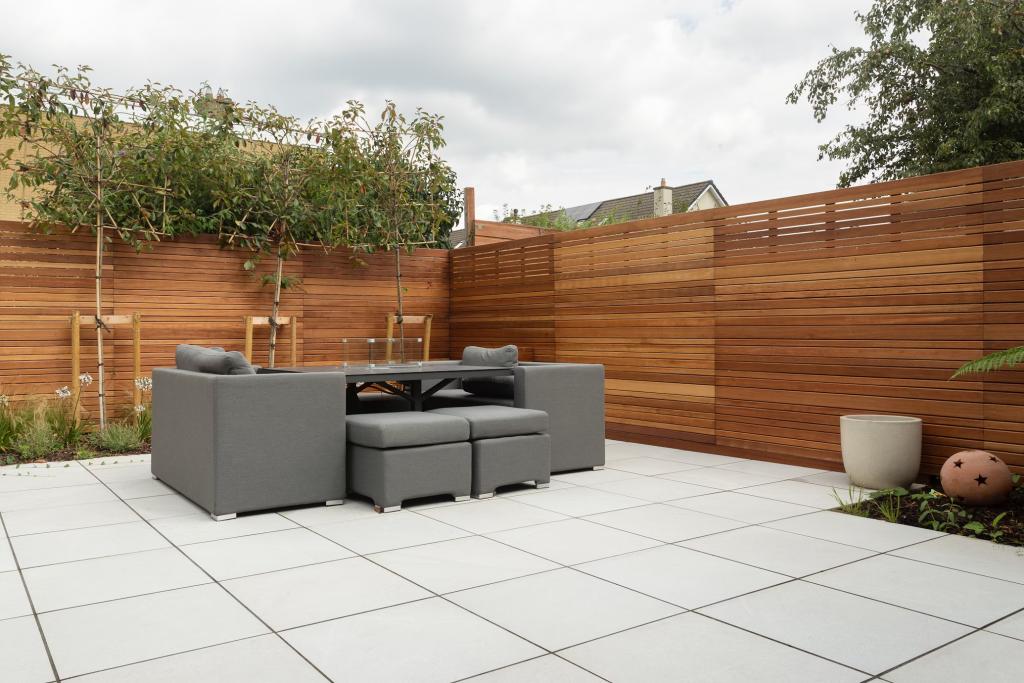Outdoor living spaces have become an integral part of many homes, allowing people to extend their living area beyond the walls of their house. These spaces are excellent places to relax, entertain, and enjoy the natural surroundings.

Whether you want to create a cosy retreat, an entertainment hub, or a garden sanctuary, understanding the basics of outdoor living spaces is essential for getting the most out of your investment. This article covers everything you need to know about designing, constructing, and maintaining outdoor living areas.
For expert design and construction services, Bowies can help bring your vision to life with top-quality craftsmanship.
What Are Outdoor Living Spaces?
An outdoor living space is essentially an extension of your indoor living area, designed to bring the comforts of the indoors outside. These spaces range from a simple patio or deck to a fully-equipped outdoor kitchen and entertainment area. The main purpose of these spaces is to increase the usable living space of your home while providing a natural environment for relaxation, dining, and socialising.
Types Of Outdoor Living Spaces
Outdoor living spaces can be categorised based on design, functionality, and location. Below are the most common types of outdoor living spaces:
- Patios and Decks—Patios and decks are the most popular outdoor living spaces. These paved or wooden platforms are located directly outside your home and are perfect for dining, lounging, or enjoying a quiet evening.
- Outdoor Kitchens – A growing trend is the outdoor kitchen, with built-in grills, countertops, refrigerators, and sinks. These kitchens make entertaining more convenient by keeping you outside and near your guests.
- Pergolas and Gazebos – These structures are designed to provide shade and protection from the sun while offering a cosy, shaded spot for gatherings. Pergolas typically feature open roofs, while gazebos offer full coverage.
- Fire Pits and Outdoor Fireplaces – A fire pit or outdoor fireplace adds warmth and ambience to your outdoor living area. These features are perfect for chilly evenings, enhancing your space’s comfort and cosiness.
How To Design An Outdoor Living Space?
Designing an outdoor living space can seem daunting, but you can easily create a functional and beautiful area by breaking it down into manageable steps. Here’s how to get started:
1. Define Your Purpose
Before you begin any design, it’s important to define the purpose of the space. Ask yourself:
- Will it be used for relaxation, dining, or entertaining?
- Do you want a private retreat or an open, communal area?
- What specific features do you need, such as an outdoor kitchen or fire pit?
2. Consider Your Space
Take into account the size and shape of your outdoor area. Consider factors like:
- The existing landscape
- Access to the home
- Privacy from neighbours
- Sunlight and wind direction
The space should be planned in a way that maximises comfort and functionality.
3. Choose The Right Materials
Choosing the right materials for your outdoor space is essential for durability and aesthetics. Some of the best materials include:
- Decking—Timber, composite decking, or stone tiles can be used as patio and deck flooring.
- Furniture – Opt for weather-resistant furniture made of teak, aluminium, or synthetic wicker materials.
- Hardscaping – Use natural stone, bricks, or concrete for pathways, retaining walls, and outdoor fireplaces.
4. Incorporate Greenery
Greenery and landscaping can enhance the beauty of your outdoor living space. Consider planting:
- Trees for shade and privacy
- Flowers and shrubs for colour and texture
- Herb gardens for a practical and aromatic addition
Key Features Of Outdoor Living Spaces
Incorporating the right features into your outdoor living space will make it more functional and enjoyable. Here are some essential features to consider when designing your outdoor area:
1. Seating Areas
A comfortable seating arrangement is a must for any outdoor living space. Consider:
- Lounge chairs, sofas, and benches for relaxation
- Dining tables for meals and social gatherings
- Hammocks or swing chairs for added comfort
2. Lighting
Outdoor lighting helps set the mood for evening gatherings. There are several types of outdoor lighting options, including:
- String lights for a soft, warm glow
- Spotlights for highlighting garden features or pathways
- Lanterns and candles for a rustic touch
3. Shade Solutions
In Australia’s hot climate, shade is essential. A pergola, gazebo, or retractable awning can protect you from the sun while adding a stylish element to your outdoor space.
4. Outdoor Heating And Cooling
Consider adding heating or cooling features to your outdoor space, depending on your location. A patio heater or fireplace is perfect for colder months, while a misting system can help cool down the space during the summer.
Outdoor Living Spaces In Australian Homes
Australia’s outdoor lifestyle heavily influences how outdoor living spaces are designed. Australians love spending time outdoors, enjoying the sunny weather, and hosting gatherings. Here’s what makes outdoor living in Australia unique:
Blending Indoor And Outdoor Living
Australian homes often feature large sliding or bi-fold doors that connect the indoor living space with the outdoor area. This seamless transition enhances the flow between the two spaces, making them feel like one large living area.
Emphasis On Low-Maintenance Gardens
With Australia’s hot and dry climate, many people opt for low-maintenance landscaping. Drought-resistant plants, artificial turf, and simple garden designs can help create a stunning yet practical outdoor area.
Outdoor Entertaining Culture
Australians are known for their love of outdoor entertaining, whether it’s a casual BBQ or a more formal dinner party. Outdoor kitchens, BBQ areas, and spacious dining settings are staples in Australian outdoor living areas.
How To Maintain Your Outdoor Living Space?
Maintaining your outdoor living space is crucial to ensure it remains in good condition for years. Here are some tips for keeping your space clean and functional:
Regular Cleaning
Outdoor furniture, decking, and hardscaping can accumulate dirt and debris. Regular cleaning will help maintain their appearance and prevent damage. Use a pressure washer for patios, decks, and walls, and a soft cloth for furniture.
Inspect And Repair
Inspect your outdoor living space regularly for any signs of wear and tear. Check for loose decking boards, cracks in the pavement, or rusting furniture. Addressing minor repairs early can save you money in the long run.
Protect From The Elements
Certain elements, like rain and sun, can cause damage depending on the materials used. Consider applying weather-resistant coatings or covers to protect your furniture and structures.
Budgeting For Outdoor Living Spaces
Creating an outdoor living space can be an investment, so planning and budgeting are important. Here are some tips for staying within your budget:
- Set a Realistic Budget – Determine how much you’re willing to spend and allocate funds for design, materials, and construction.
- DIY vs. Professional Help – Depending on your skill level, you can complete some work yourself or hire professionals for certain tasks.
- Prioritise Features – Focus on the most important features, such as a deck or seating area, before adding smaller items like lighting or landscaping.
Conclusion
Understanding the basics of outdoor living spaces is essential to designing a functional and enjoyable space. You can create an outdoor sanctuary that fits your needs by defining your space’s purpose, choosing the right materials, and incorporating key features like seating areas, lighting, and shade solutions.
With proper maintenance, your outdoor living space will continue to be a source of enjoyment for years.
Frequently Asked Questions
What Is The Best Material For An Outdoor Deck Or Patio?
The best outdoor deck or patio material depends on your budget and aesthetic preferences. Timber is popular for its natural look, while composite decking offers low-maintenance benefits. Natural stone or concrete pavers are durable and versatile options for patios. When choosing, consider factors like durability, maintenance, and weather resistance.
How Can I Keep My Outdoor Living Space Cool During The Summer?
Add shade solutions like pergolas, retractable awnings, or umbrellas to keep your outdoor living space cool. You can also install a misting system or ceiling fans to enhance airflow. Light-coloured furniture and materials that reflect the sun’s heat can help maintain a comfortable temperature during hot days.
How Do I Maintain My Outdoor Living Space During The Winter Months?
Maintaining your outdoor space in winter involves protecting furniture and structures from the harsh weather. Use covers for outdoor furniture and inspect decking for any damage caused by freezing temperatures. It’s also essential to clean gutters, remove debris to prevent buildup, and ensure your space stays in top condition when the weather warms up.
